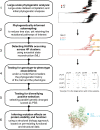Parallel evolution in the emergence of highly pathogenic avian influenza A viruses
- PMID: 33139731
- PMCID: PMC7608645
- DOI: 10.1038/s41467-020-19364-x
Parallel evolution in the emergence of highly pathogenic avian influenza A viruses
Erratum in
-
Publisher Correction: Parallel evolution in the emergence of highly pathogenic avian influenza A viruses.Nat Commun. 2020 Nov 23;11(1):6070. doi: 10.1038/s41467-020-20006-5. Nat Commun. 2020. PMID: 33230170 Free PMC article.
Abstract
Parallel molecular evolution and adaptation are important phenomena commonly observed in viruses. Here, we exploit parallel molecular evolution to understand virulence evolution in avian influenza viruses (AIV). Highly-pathogenic AIVs evolve independently from low-pathogenic ancestors via acquisition of polybasic cleavage sites. Why some AIV lineages but not others evolve in this way is unknown. We hypothesise that the parallel emergence of highly-pathogenic AIV may be facilitated by permissive or compensatory mutations occurring across the viral genome. We combine phylogenetic, statistical and structural approaches to discover parallel mutations in AIV genomes associated with the highly-pathogenic phenotype. Parallel mutations were screened using a statistical test of mutation-phenotype association and further evaluated in the contexts of positive selection and protein structure. Our resulting mutational panel may help to reveal new links between virulence evolution and other traits, and raises the possibility of predicting aspects of AIV evolution.
Conflict of interest statement
The authors declare no competing interests.
Figures





References
Publication types
MeSH terms
Substances
Grants and funding
LinkOut - more resources
Full Text Sources
Medical

